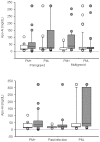Plasma levels of apolipoprotein A1 in malaria-exposed primigravidae are associated with severe anemia
- PMID: 20098675
- PMCID: PMC2809092
- DOI: 10.1371/journal.pone.0008822
Plasma levels of apolipoprotein A1 in malaria-exposed primigravidae are associated with severe anemia
Abstract
Background: Plasmodium falciparum placental malaria (PM) contributes to 10,000 maternal deaths due to severe anemia (SA) each year in Africa, primarily among primigravid women who are most susceptible. Increased levels of proinflammatory cytokines like TNF-alpha are associated with maternal anemia in first time mothers but not in other women. Here we aimed to identify additional changes in the plasma proteome associated with pregnancy malaria that may contribute to the development of malaria-related maternal anemia.
Principal findings: A semi-quantitative mass spectrometry approach was used to compare the relative abundance of plasma proteins in anemic versus non-anemic women with PM. Levels of 24 proteins differed significantly between anemic and non-anemic primigravidae, including several lipid metabolism proteins and molecular transport proteins involved in the acute phase response signaling network. These differences were not observed in multigravid women who enjoy specific immunity that protect them from PM. In a confirmatory study of a larger cohort of primigravid women, levels of the lipid metabolism protein Apolipoprotein (Apo)-AI were significantly lower in PM+ women with SA.
Conclusions: Apo-AI levels are significantly lower in severely anemic primigravidae with PM, and ApoA1 levels positively correlate with hemoglobin levels in primigravid but not multigravid women. Apo-AI is known to have anti-inflammatory effects, and thus Apo-AI reductions may contribute to the inflammatory processes that result in SA.
Conflict of interest statement
Figures



Similar articles
-
The Development, Fine Specificity, and Importance of High-Avidity Antibodies to VAR2CSA in Pregnant Cameroonian Women Living in Yaoundé, an Urban City.Front Immunol. 2021 Feb 26;12:610108. doi: 10.3389/fimmu.2021.610108. eCollection 2021. Front Immunol. 2021. PMID: 33717094 Free PMC article.
-
Impact of placental Plasmodium falciparum malaria on the profile of some oxidative stress biomarkers in women living in Yaoundé, Cameroon.PLoS One. 2015 Aug 12;10(8):e0134633. doi: 10.1371/journal.pone.0134633. eCollection 2015. PLoS One. 2015. PMID: 26267795 Free PMC article.
-
Maternal peripheral blood level of IL-10 as a marker for inflammatory placental malaria.Malar J. 2008 Jan 29;7:26. doi: 10.1186/1475-2875-7-26. Malar J. 2008. PMID: 18230163 Free PMC article.
-
Plasmodium in the placenta: parasites, parity, protection, prevention and possibly preeclampsia.Parasitology. 2007;134(Pt 13):1877-81. doi: 10.1017/S0031182007000170. Parasitology. 2007. PMID: 17958923 Review.
-
Do Antibodies to Malaria Surface Antigens Play a Role in Protecting Mothers From Maternal Anemia?Front Immunol. 2020 Dec 18;11:609957. doi: 10.3389/fimmu.2020.609957. eCollection 2020. Front Immunol. 2020. PMID: 33391279 Free PMC article. Review.
Cited by
-
KSHV oral shedding and plasma viremia result in significant changes in the extracellular tumorigenic miRNA expression profile in individuals infected with the malaria parasite.PLoS One. 2018 Feb 9;13(2):e0192659. doi: 10.1371/journal.pone.0192659. eCollection 2018. PLoS One. 2018. PMID: 29425228 Free PMC article.
-
High-density lipoprotein modulates thrombosis by preventing von Willebrand factor self-association and subsequent platelet adhesion.Blood. 2016 Feb 4;127(5):637-45. doi: 10.1182/blood-2014-09-599530. Epub 2015 Nov 9. Blood. 2016. PMID: 26552698 Free PMC article.
-
Ability of a biomarker-based score to predict death from circulatory disease and cancer in NHANES III.BMC Public Health. 2012 Oct 23;12:895. doi: 10.1186/1471-2458-12-895. BMC Public Health. 2012. PMID: 23092358 Free PMC article.
-
Serum Apolipoprotein-A1 and Cholesterol Levels in Nigerian Children with Plasmodium falciparum Infection.Med Princ Pract. 2015;24(4):318-24. doi: 10.1159/000430812. Epub 2015 May 27. Med Princ Pract. 2015. PMID: 26021459 Free PMC article.
-
Correlation of apolipoprotein A-I kinetics with survival and response to first-line platinum-based chemotherapy in advanced non-small cell lung cancer.Med Oncol. 2015 Jan;32(1):407. doi: 10.1007/s12032-014-0407-8. Epub 2014 Dec 3. Med Oncol. 2015. PMID: 25465061
References
-
- Zucker JR, Lackritz EM, Ruebush TK, 2nd, Hightower AW, Adungosi JE, et al. Childhood mortality during and after hospitalization in western Kenya: effect of malaria treatment regimens. Am J Trop Med Hyg. 1996;55:655–660. - PubMed
-
- Fleming AF. Tropical obstetrics and gynaecology. 1. Anaemia in pregnancy in tropical Africa. Trans R Soc Trop Med Hyg. 1989;83:441–448. - PubMed
-
- Shulman CE, Marshall T, Dorman EK, Bulmer JN, Cutts F, et al. Malaria in pregnancy: adverse effects on haemoglobin levels and birthweight in primigravidae and multigravidae. Trop Med Int Health. 2001;6:770–778. - PubMed
-
- Fried M, Duffy PE. Adherence of Plasmodium falciparum to chondroitin sulfate A in the human placenta. Science. 1996;272:1502–1504. - PubMed
-
- Duffy PE, Desowitz RS. Pregnancy malaria throughout history: Dangerous labor. In: Duffy PE, Fried M, editors. Malaria in Pregnancy: Deadly Parasite, Susceptible host. London: Taylor & Francis; 2001. pp. 1–25.
Publication types
MeSH terms
Substances
Grants and funding
LinkOut - more resources
Full Text Sources
Miscellaneous

